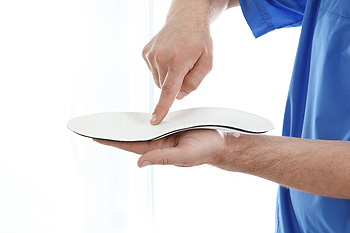Items filtered by date: September 2024
Get Proper Treatment for Ankle Injuries
Negative Effects of Working on Your Feet

Working on your feet for long hours can lead to a variety of foot-related issues. The constant stress on the bones, muscles, and tendons can cause inflammation, pain, and even permanent structural changes. The foot's arches, which normally act as shock absorbers, may weaken due to prolonged standing or walking, leading to flat feet. This loss of arch support can affect not only the feet but also the knees, hips, and lower back, making them more vulnerable to injury. Painful foot conditions related to working on the feet include plantar fasciitis, Achilles tendonitis, and bunions, all of which may worsen with time. Symptoms like fatigue, pain, and discomfort often spread from the feet to the legs and back, making it difficult to continue standing or walking for extended periods. If you have foot pain related to working on your feet, it is suggested that you make an appointment with a podiatrist for an exam, diagnosis, and treatment options.
While working on the feet, it is important to take the proper care of them. For more information about working on your feet, contact Kenneth Williams, DPM from Texas. Our doctor will treat your foot and ankle needs.
Working on Your Feet
Standing on your feet for long periods of time can cause stress and pain in your feet. Your whole body may experience change in terms of posture, back pain, bunions, callouses and or plantar warts. There are ways to avoid these conditions with proper foot care, smart choices and correct posture.
Positive Changes
Negative heeled shoe – Choosing this shoe type places the heel slightly lower than the ball of the foot. These are great for overall foot health. Find shoes that fit you correctly.
Go barefoot – Our feet were not designed to be enclosed for all hours of the day. Try to periodically expose your feet to air.
Eliminate Pain
Foot Exercises – Performing simple exercises, incorporating yoga and doing stretches are beneficial. This will allow increased blood flow to the area and muscles of the foot.
Achilles tendon – Stretching the foot out flat on the floor will relax the calf muscles and tendon. These exercises can be performed almost anywhere. Make sure you add these exercises to your daily regimen.
With a little bit of this information and knowing more about foot health, you will notice changes. Foot stretches and proper footwear will help with pain and prevent further issues.
If you have any questions please feel free to contact our office located in San Antonio and Beeville, TX . We offer the newest diagnostic and treatment technologies for all your foot and ankle needs.
What Is Gout?

Gout is a type of arthritis caused by the accumulation of uric acid crystals in the joints, leading to sudden, severe pain and inflammation. It commonly affects the big toe but can impact other joints as well. Early symptoms of gout include intense pain, swelling, redness, and warmth in the affected joint, often starting abruptly at night. If left untreated, gout can lead to chronic joint damage, kidney stones, and decreased mobility. Certain factors increase the risk of developing gout, such as a high-purine diet, obesity, and genetic predisposition. Diagnosis typically involves a combination of medical history, physical examination, and laboratory tests to measure uric acid levels and confirm crystal presence through joint fluid analysis or imaging. Managing gout effectively can require medication and lifestyle changes. If you experience persistent big toe pain from gout, it is suggested you schedule an appointment with a podiatrist for a thorough diagnosis and personalized treatment plan.
Gout is a foot condition that requires certain treatment and care. If you are seeking treatment, contact Kenneth Williams, DPM from Texas. Our doctor will treat your foot and ankle needs.
What Is Gout?
Gout is a type of arthritis caused by a buildup of uric acid in the bloodstream. It often develops in the foot, especially the big toe area, although it can manifest in other parts of the body as well. Gout can make walking and standing very painful and is especially common in diabetics and the obese.
People typically get gout because of a poor diet. Genetic predisposition is also a factor. The children of parents who have had gout frequently have a chance of developing it themselves.
Gout can easily be identified by redness and inflammation of the big toe and the surrounding areas of the foot. Other symptoms include extreme fatigue, joint pain, and running high fevers. Sometimes corticosteroid drugs can be prescribed to treat gout, but the best way to combat this disease is to get more exercise and eat a better diet.
If you have any questions please feel free to contact our office located in San Antonio and Beeville, TX . We offer the newest diagnostic and treatment technologies for all your foot and ankle needs.
The Do’s and Don’ts of Diabetic Foot Care

Diabetic foot care is crucial for avoiding complications and maintaining foot health. Do regularly inspect your feet for cuts, blisters, or changes in skin color, as diabetes can impair sensation and delay healing. Clean your feet daily with mild soap and water, and keep them dry, especially between the toes, to prevent infections. Always wear well-fitting, supportive shoes to avoid blisters and sores. Regular visits to a podiatrist can help detect potential issues early. Do not walk barefoot, as this increases the risk of injury and infection. Avoid using hot water bottles or heating pads on your feet, as reduced sensation can lead to burns. Do not self-treat or attempt to cut corns or calluses, as this can cause injury. If you have diabetes, it is suggested that you regularly visit a podiatrist who can help you to manage this condition.
Diabetic foot care is important in preventing foot ailments such as ulcers. If you are suffering from diabetes or have any other concerns about your feet, contact Kenneth Williams, DPM from Texas. Our doctor can provide the care you need to keep you pain-free and on your feet.
Diabetic Foot Care
Diabetes affects millions of people every year. The condition can damage blood vessels in many parts of the body, especially the feet. Because of this, taking care of your feet is essential if you have diabetes, and having a podiatrist help monitor your foot health is highly recommended.
The Importance of Caring for Your Feet
- Routinely inspect your feet for bruises or sores.
- Wear socks that fit your feet comfortably.
- Wear comfortable shoes that provide adequate support.
Patients with diabetes should have their doctor monitor their blood levels, as blood sugar levels play such a huge role in diabetic care. Monitoring these levels on a regular basis is highly advised.
It is always best to inform your healthcare professional of any concerns you may have regarding your feet, especially for diabetic patients. Early treatment and routine foot examinations are keys to maintaining proper health, especially because severe complications can arise if proper treatment is not applied.
If you have any questions please feel free to contact our office located in San Antonio and Beeville, TX . We offer the newest diagnostic and treatment technologies for all your foot and ankle needs.
The Benefits of Orthotic Use in Runners

Orthotics can significantly impact a runner's speed, comfort, and injury prevention. These custom-made shoe inserts are designed to support and align the feet, addressing issues like flat feet, high arches, or pronation problems. By providing proper foot alignment, orthotics can improve a runner's biomechanics, leading to a more efficient stride and potentially increasing speed. Comfort is another key benefit of orthotics, as they can help distribute pressure evenly across the foot, reducing the risk of blisters, calluses, and other discomforts that can slow a runner down. Additionally, by correcting imbalances and providing necessary support, orthotics can prevent common running injuries, such as plantar fasciitis, shin splints, and stress fractures. For runners, the right orthotic can enhance performance by making each step more efficient and reducing the likelihood of injury. If you are a runner seeking to enhance your performance and prevent injuries, it is suggested that you consult a podiatrist to see if orthotics can help you.
If you are having discomfort in your feet and would like to try orthotics, contact Kenneth Williams, DPM from Texas. Our doctor can provide the care you need to keep you pain-free and on your feet.
What Are Orthotics?
Orthotics are inserts you can place into your shoes to help with a variety of foot problems such as flat feet or foot pain. Orthotics provide relief and comfort for minor foot and heel pain but can’t correct serious biomechanical problems in your feet.
Over-the-Counter Inserts
Orthotics come in a wide variety of over-the-counter inserts that are used to treat foot pain, heel pain, and minor problems. For example, arch supports can be inserted into your shoes to help correct overarched or flat feet, while gel insoles are often used because they provide comfort and relief from foot and heel pain by alleviating pressure.
Prescription Orthotics
If over-the-counter inserts don’t work for you or if you have a more severe foot concern, it is possible to have your podiatrist prescribe custom orthotics. These high-quality inserts are designed to treat problems such as abnormal motion, plantar fasciitis, and severe forms of heel pain. They can even be used to help patients suffering from diabetes by treating foot ulcers and painful calluses and are usually molded to your feet individually, which allows them to provide full support and comfort.
If you are experiencing minor to severe foot or heel pain, it’s recommended to speak with your podiatrist about the possibilities of using orthotics. A podiatrist can determine which type of orthotic is right for you and allow you to take the first steps towards being pain-free.
If you have any questions please contact our office located in San Antonio and Beeville, TX . We offer the newest diagnostic and treatment technologies for all your foot and ankle needs.

